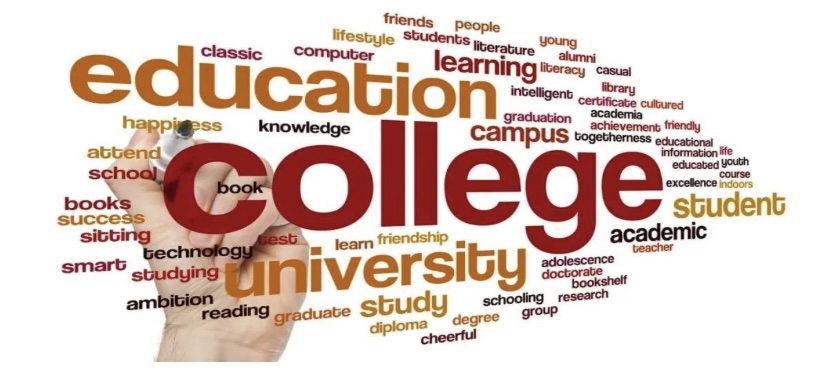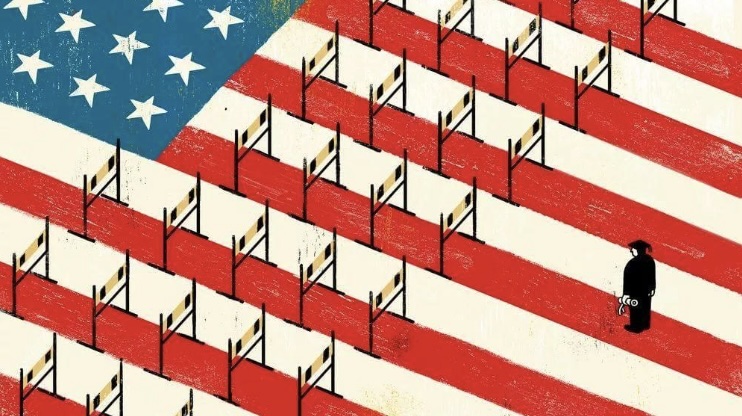Apr 16 (News On Japan) - 18-year-old Zach Adgarian is considered a genius. He scored 34 out of 36 on the ACT, which, along with the SAT, is a primary criterion for college admissions in the U.S.

He is also a programmer who developed an app that calculates the calorie content of food by analyzing photos from menus. He runs his own company, earning $30 million annually.
What shocked Adgarian, however, was that all the Ivy League universities he applied to rejected him. A hacker infiltrated the admissions system at New York University and found that a Hispanic student and several Black applicants, whose scores were significantly lower than Adgarian's, were accepted. If Adgarian were not White, he would undoubtedly have been accepted. Last year, a U.S. court ruled that race-based quotas in college admissions are illegal.
Adgarian is not alone. Stanley Zhong, who was hired by Google at age 13 for a "PhD-level" position, also faced rejection from at least 16 Ivy League schools, despite ranking in the top 2000 in the SAT. Zhong's father angrily told the media, "I’ve heard that Asian applicants face higher admissions standards, but I thought that was just a rumor. When I received one rejection letter after another, I was shocked. What started as surprise turned into frustration and, eventually, anger."
Zhong's parents sued several universities for racial discrimination, but the unfairness he faced is unlikely to be rectified.
In the face of the "U.S. universities don't accept geniuses" rule, both Adgarian and Zhong are victims.
The Elite Only Value “Bling” Over Talent
For a society like the U.S., which suffers from "systemic racism," it’s no surprise that Zhong was rejected, but why was Adgarian also turned away?

A hacker leaked Adgarian’s college application essay. A university professor online commented, “Many students have scores similar to Adgarian’s, but they present themselves more humbly, overcoming terrible environments while appearing modest.” Adgarian, however, came across as too eager, focusing relentlessly on his accomplishments and skills, which admissions officers easily dismissed as arrogance.
In the U.S., writing a 750-word college essay is no small feat. Admissions officers aren’t looking for talent in this essay; they want to see your “vision.” Students who can describe their difficult educational journeys, remain humble, and use polished, sophisticated language tend to succeed. Many families send their children to tutoring classes specifically to learn how to craft such essays. Some high-achieving students even hire university professors to write their essays for them.
Many Asian immigrant parents encourage their children to practice the piano, but Ivy League admissions officers dismiss this as “just another piano-playing Asian nerd.” In contrast, U.S. scholar Yascha Munk wrote about a college classmate who was accepted to an Ivy League school for stating that his house was destroyed during the “Troubles” in Northern Ireland. This emotional story successfully impressed the admissions officers. The truth, however, was that the student attended the elite British school Eton, had multiple properties, and the house that was destroyed was just one of them.
Adgarian’s misfortune lies in the fact that neither his parents nor relatives work at universities, so no one was there to guide him on these “tricks.” On the surface, U.S. universities appear to be holistic, where essays assess "comprehensive ability," yet this system introduces new forms of inequality.
Yascha Munk sarcastically pointed out that today in the U.S., ambitious students don’t wait until they’re 16 or 17 to think about how to express their personalities—they start preparing for a perfect college application essay at the age of 12 or 13. To enter the elite, they exaggerate, pose, and boast about their taste, willpower, and eccentricities. This has become the hallmark of today’s American elite.
Universities Have Become Institutions That Produce Mediocre Individuals
Why do top U.S. universities employ such strange admissions methods?

David Brooks, an American writer, delves into the history, explaining that American universities originally served the elite. From the late 19th century until the 1950s, they mainly catered to old-school WASP (White Anglo-Saxon Protestant) families born into elite social circles in places like Fifth Avenue in New York, Main Line in Philadelphia, and Beacon Hill in Boston. They graduated from prep schools like Groton or Choate and attended universities like Harvard, Yale, or Princeton. Admission was based on "social skills"—good looks, athletic ability, elegance, and effortless sophistication.
University was never about academics. It was about entering elite clubs: Princeton's Ivy League, Yale's Skull and Bones, and Harvard's Porsche Club. Graduates would go on to prestigious law firms, top banks, the State Department, and even the White House. From 1901 to 1921, every U.S. president had attended Harvard, Yale, or Princeton.
However, in 1933, Harvard President James Conant sought to change this. He hoped to select the smartest individuals from all walks of life, in line with Thomas Jefferson’s ideals. Though Conant's rhetoric was grand, 94% of Harvard’s students were still recommended by aristocratic families. His successors implemented this vision, and today, Ivy League universities judge applicants’ "taste" through their admissions essays.
The result? The era of elite-dominated higher education produced graduates who achieved great things, such as the progressive movement, the New Deal, victory in WWII, the Marshall Plan, NATO's establishment, and the end of the Cold War. After breaking this monopoly, however, graduates began making foolish decisions: the Vietnam and Afghanistan quagmires, the Iraq massacre, the 2008 financial crisis, the harmful rise of social media, and the current dysfunctional political environment.
Moreover, class divisions have intensified. According to Brooks, 59% of Americans believe the country is in decline, and 63% think experts don’t understand their lives. Today's elite class has created a new caste system. High school graduates earn $1 million less over their lifetimes than college graduates. They are twice as likely to divorce, four times as likely to have children out of wedlock, and suffer ten times the mortality rate from opioids. While 25% of non-college graduates have no close friends, only 10% of college graduates share that statistic.
Instead of advancing society, the elites produced by U.S. universities have done little to improve it.
Colleges Are Widening America's Social Divide
Why aren’t U.S. universities producing true elites anymore?
Since the 1920s, Stanford University psychologist Lewis Terman’s team tracked about 1,500 high-IQ children. As adults, they earned 97 PhD degrees, 92 law degrees, and held respectable jobs such as doctors, lawyers, and professors, but none of them became transformative figures.
In a 2019 paper, Vanderbilt researchers surveyed 677 students who scored in the top 1% of the SAT at age 13. They found that 88% of these individuals never achieved success in life.
David Brooks argues that American elite education is trapped in a web of false metrics. Instead of selecting and nurturing geniuses, it merely selects those who are best adapted to this system—individuals who know how to convince themselves and others that mistaken ideas are correct.
The key issue? The game has been rigged.
Elite systems should categorize people based on innate ability, but wealthy parents invest more in their children, giving them a head start. In 1985, 46% of students in America’s top 250 universities came from the wealthiest families. By 2000, this increased to 55%. By 2006, it was 67%. In 2017, students from the top 1% of income families were 77 times more likely to be admitted to Ivy League schools than those from families earning less than $30,000 annually.
Colleges should serve talented youth, but instead, they now cater to mediocre children of wealthy families. The result? Universities no longer increase human capacity but instead reinforce the self-identity and illusions of the elite.
Turning Geniuses Into Mediocrities Controlled by Capital
Today’s elite universities no longer nurture creative thinkers, instead serving as instruments of social resource allocation. This has led to the corruption of the American elite—they live for the approval of others and have lost themselves in the process.
Those so-called geniuses, like Adgarian and Zhong, are clearly unable to join the ranks of today’s elite.

"I know almost nothing about finance, but damn it, I need to make money." Audrey, a freshman at Harvard University’s Kennedy School of Government, told reporter Zach Marcus.
Having graduated from an “extremely wealthy” high school, Audrey is convinced that she must secure a high-paying job upon graduating from university. She originally had an interest in law and had even volunteered at a legal center, intending to work for women's equality. However, now she must set her interests aside. As a student at Harvard, if she can land an internship and perform well, she will secure a high-paying job, and within two years, she'll be able to switch to a new, highly lucrative position.
With soaring tuition fees and skyrocketing dormitory rents, many American students rely on loans to sustain themselves, which they may still be paying off well into their 70s. A recent survey of U.S. freshmen reveals that today’s young people are even more eager to make money. They feel they need nearly $600,000 to feel "successful"—$500,000 more than previous generations. The finance sector is considered the most desirable and stable career path for young people.
Scholar Bind notes that beyond the increased economic pressures, there is also the phenomenon of the “career funnel,” where young people are more focused on winning in the selection process, disregarding whether the career truly suits them. For example, in the 1950s and 60s, the most coveted jobs in elite American campuses were positions in the State Department or CIA, which paid little at the time. The allure was the respect and prestige these roles conferred.
Audrey admits, “I’m very competitive. It feels like the next big competition.” She hasn’t considered that she has already fallen into the trap designed by the American elite—being controlled by others’ desires. This is precisely the underlying logic of how contemporary American universities operate: transforming more and more American students into tools for the elite class, making them forget their true talents and aspirations, turning geniuses into mediocrities controlled by capital.
Individuals like Adgarian and Zhong clearly cannot join this system.















